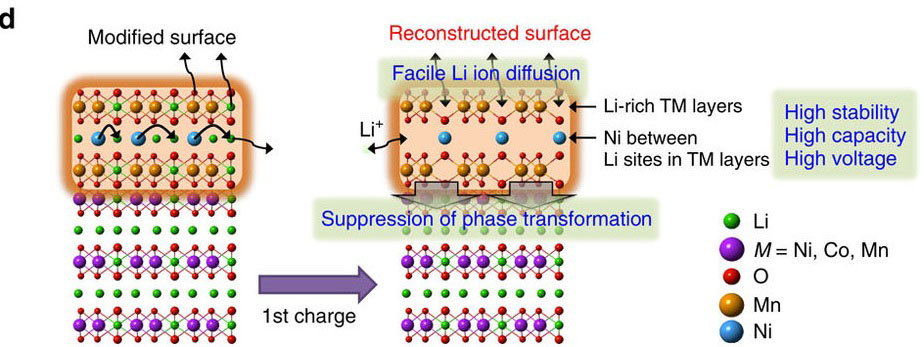リチウムリッチ層状正極活物質のための安定なリチウムリッチ表面構造
A stable lithium-rich surface structure for lithium-rich layered cathode materials
2016年11月25日 Nature Communications 7 : 13598 doi: 10.1038/ncomms13598

リチウムイオン電池のエネルギー密度は、常にさらなる増加が求められている。この要求をかなえる現実的な解決策として、リチウムを豊富に含んだ層状酸化物の正極活物質が考えられる。こうした酸化物は、遷移金属層にもリチウムが存在するため、比容量が200 mAh g-1を超える。しかし、このようなリチウム配置は、次々に遷移金属とのミキシングを引き起こすため、サイクル中に構造相転移が起き、可逆容量を低下させることになる。今回我々は、遷移金属層間にニッケルが規則正しく配置しており、かつ、ホストであるリチウムリッチ層状酸化物と整合した骨格を有するリチウムリッチ層状表面について報告する。この表面構造によって、不要な相転移が抑制され、サイクル安定性が向上している。また、この表面改質によって、1 C(250 mA g-1)で218.3 mAh g-1の可逆容量が得られるとともに、サイクル保持率が向上している(100サイクル後94.1%)。今回の表面設計は、表面から構造劣化が進行するさまざまな電池電極に適用可能である。
Corresponding Authors
Lithium ion batteries are encountering ever-growing demand for further increases in energy density. Li-rich layered oxides are considered a feasible solution to meet this demand because their specific capacities often surpass 200 mAhg-1 due to the additional lithium occupation in the transition metal layers. However, this lithium arrangement, in turn, triggers cation mixing with the transition metals, causing phase transitions during cycling and loss of reversible capacity. Here we report a Li-rich layered surface bearing a consistent framework with the host, in which nickel is regularly arranged between the transition metal layers. This surface structure mitigates unwanted phase transitions, improving the cycling stability. This surface modification enables a reversible capacity of 218.3 mAh g-1 at 1C(250 mA g-1)with improved cycle retention (94.1% after 100 cycles). The present surface design can be applied to various battery electrodes that suffer from structural degradations propagating from the surface.

